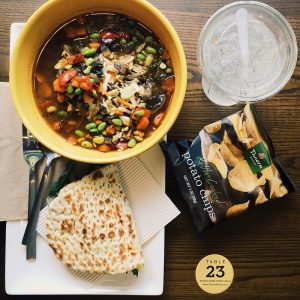Panera Soba Noodle Bowl Review

Product Name: Panera Soba Noodle Bowl
Product Description: Panera Bread features four broth bowls on their menu, two of which are vegan: Soba Noodle Bowl with Chicken, Soba Noodle Bowl with Edamame, Lentil Quinoa Bowl with Chicken, and Vegan Lentil Quinoa Broth Bowl.
Brand: Panera Bread
Offer price: 9.49
Currency: USD
Availability: InStock
To meat or not to meat? That is the question you have to ask yourself when deciding on which delicious Panera Bread option to choose. Luckily, the restaurant offers so many flavorful meatless options; you’ll never have to sacrifice flavor in the name of eating healthy. The same goes for Panera Bread’s Soba Noodle Bowls, offered with or without chicken. Even the miso broth is fishless, so this is an excellent option for vegetarians and vegans. Let’s dig into this tasty meal in our Panera Soba Noodle Bowl review.
History and Inspiration
Panera launched their new Asian-Inspired broth bowls in January of 2015- right in the middle of winter. What better way to warm up from the cold than with a comforting bowl of noodles and veggies? Panera Bread changes up their menu a few times a year, as their customers like lots of options. Besides that, customers are more health-conscious these days, opting for healthier meals, most notably, vegan and vegetarian options. The sandwich and salad chain decided to give their customers exactly what they wanted – more options within more options. When they introduced their Soba Noodle Bowls, they launched four different options, two with chicken and two without. This made us all happy! Being able to eat well and cut down on meat consumption sat well with Panera customers, so now the Soba Noodle bowls are here to stay.
Types of Soba Noodle Bowls
Panera Bread features four broth bowls on their menu, two of which are vegan.
Soba Noodle Bowl with Chicken – This bowl is made with antibiotic-free chicken, soba buckwheat noodles, fresh spinach, napa cabbage blend, roasted mushroom, onion, sesame seeds, and cilantro in umami soy-miso broth.
Soba Noodle Bowl with Edamame – This bowl is made with soy-based miso soup (instead of fish-based), soba buckwheat noodles, fire-roasted edamame, sesame seeds, and napa cabbage.
Lentil Quinoa Bowl with Chicken – This bowl is made with antibiotic-free chicken, organic quinoa and organic brown rice, lentil blend, tomato sofrito, fresh kale, and spinach with a lemon in umami soy-miso broth.
Vegan Lentil Quinoa Broth Bowl – This bowl is made with soy-based miso soup (same as the other), along with protein-filled quinoa and lentils, tomato sofrito, kale, and more.
Panera Soba Noodle Bowl Review
Panera Bread’s Soba Noodle Bowls are a welcomed addition to the menu as customers choose more health-conscious meals these days. Did the chain create a winner here? I sure think so.

1. Taste and Texture [5/5]
Soba noodles go great with chicken or seafood, but they also work well with vegetables, making them versatile and perfect for Panera’s noodle bowls. Like most other entrees offered at Panera Bread, you can choose a baguette, apple, or chips. I always order a baguette, and it’s perfectly wonderful dipped in this broth. The unami soy-miso broth is a mild noodle broth with a bit of tang and heat, but overall it’s a light flavor. Because it’s a vegetarian-based broth, it’s missing the savory beef or chicken flavors, but if you order your bowl with chicken, problem solved. There’s a fair amount of chicken in the bowl that is both moist and tender, and because it’s seasoned with a citrus and pepper blend, it adds a unique flair to the bowl. Of course, you can also order this bowl with edamame instead of chicken, making this a vegan-friendly choice. All of the veggies taste great together, and it’s a tasty, interesting option.

2. Are they healthy? [5/5]
While it isn’t labeled, the Soba Noodle Broth Bowl is vegan-friendly. It uses the same fishless umami broth as the other vegan broth bowl. This bowl comes with soba buckwheat noodles, fire-roasted edamame (or chicken), sesame seeds, and napa cabbage to reduce the use of wheat-based grains. This adds to the list of vegan-friendly options Panera Bread offers, like the Vegetarian Black Bean Soup, Mediterranean Veggie Sandwich (minus the feta), Peach and Blueberry Smoothie with Almond Milk, and the Modern Greek Salad with Quinoa minus feta). Buckwheat has benefits for blood sugar, heart health, inflammation, and cancer prevention, and the noodles are more healthy than white rice. The Soba Noodle Bowls are also packed with protein and nutrients that will fill your belly and fuel your body.
3. Are they Worth it? [5/5]
With various options for vegans and meat-eaters alike, the Soba Noodle Bowl is an excellent lunch or dinner option. It’s packed full of ingredients, and the flavors blend in a unique, delicious way. The price is reasonable, and you can feel extra full by adding a side, like a baguette (which I highly recommend). Definitely worth it.

Final Verdict
Overall, Panera Bread’s Soba Noodle Bowl is excellent with either chicken or edamame, though I prefer the chicken. However, I love that I can purchase a filling vegan meal when I’m on a “meatless” day. I love the noodles and veggies’ flavors, and I love slurping the broth in the end. It’s healthy, the price is fair, and my kids eat it. It’s a winning combo.
Panera Soba Noodle Bowl Nutrition Facts
Panera Bread Soba Noodle Bowl with Chicken
- Calories – 390
- Fat – 9 g
- Sodium – 1340 mg
- Carbs – 47 g
- Protein – 31 g
Panera Bread Soba Noodle Bowl with Edamame
- Calories – 370
- Fat – 12g
- Sodium – 1340 mg
- Carbs – 52 g
- Protein – 17 g
Panera Soba Noodle Bowl Pricing
The Broth Bowls are available at Panera Bread nationwide as a permanent menu item. The price varies by location, but the general range is $7.99 to $9.49. While it’s not as inexpensive as some fast food choices, it’s a fair price for a filling, delicious meal.
What do you think of our Panera Soba Noodle Bowl Review?
Have you had the pleasure of trying one of Panera’s Soba Noodle Bowls? What did you think? Do you have a favorite? How does the fishless-miso soup compare to the regular miso soup we’re more accustomed to? We’d love to hear your thoughts in the comments below.
